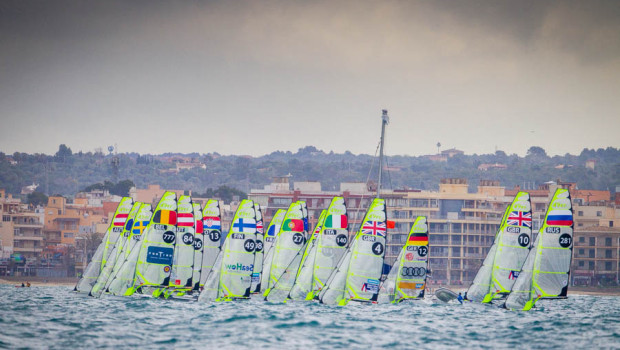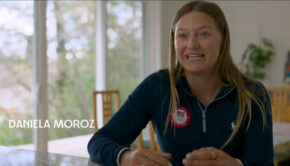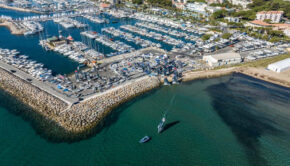Olympic Sailing: Sport versus Spectator
Published on April 20th, 2014
The desire to present sailing in a manner that provides the spectator with a viewable and understandable sport has required some adjustments to the game. Will the reward be worth the change? The Olympic skiff events, sailed in the 49er and 49erFX, believe it is. Here 49er class secretary Ben Remocker explains…
The 49er class has a tradition of pushing sailing forward, aligning to the Olympic ideals and the Olympic business model. The overall Olympic success is a complex tonic, but the core product is live sports. Live coverage of sailing is difficult and expensive. Traditionally it has also been slow paced and difficult to understand for non-sailors, the vast majority of Olympic customers. That places sailing at direct odds with the (only) people who write checks in support of the sport, a dangerous position to be in. The 49er class aims to counter all of these challenges and make Olympic sailing, at least part of it, align with the Olympic business model.
Identification number comparison small
The 49er class introduced big national flags onto our mainsails in 2010, vastly improving the ability of sailing fans to identify the teams they are cheering for. In 2013 we complimented this move with larger and simpler sail numbers to further help fans identify the teams. It’s very hard to invest emotional energy watching sport when you can’t tell who is who. The rest of sailing has replicated the country flag stickers, and may take further steps in the future.
Formats
Intense short course racing is in the DNA of the skiff looking back to our roots in the Sydney harbour 18 foot skiffs. While most Olympic classes prefer large fleet races, the 49er has been running 25 boat gold fleets and 30 minute races for almost our entire history. Shorter intense races have a better chance to entice the public to watch, even though it remains very difficult. They are also fun for sailors and have proven to be a great training ground for Olympic sailors to base pro sailing careers from.
Finals
In 2008, sailing introduced the ‘medal race’ concept to the Olympics. Fleet sizes and race duration were reduced, reinforcing the lead taken by 49er, to 10 boats and 30 minutes. This is a positive move in many respects, as the media is able to focus on a smaller pool of contenders than in large fleet, long course racing.
The challenge is to ensure a sound marriage between the finals ‘medal racing’ and the Olympic ideals of live sport. As it turns out, medal racing is still very difficult and expensive to cover live, as the course sizes are large. Further, by reducing the fleet size to only 10 boats, there is little action, and cameras end up having to focus on a single boat in a frame. Any sailing photographer will attest to the fact that a single boat in a frame makes for a boring picture, and the effect is only enhanced in video. The 49er class has been developing and proposing an alternative format to better align Olympic sailing with the Olympic business model and we’ve been calling it theatre style racing.
An example of fantastic medal race coverage came at the Perth2011 worlds. If you count the cameras there is a helicopter, 2 long lens from shore, and a gyro-stabilized high speed motorboat, along with the studio cameras. The end result is great, compelling, multi-boat frames for about the first 3 minutes of the 30 minute race. From half way up the first beat, they start having to resort more often to single boat shots, and by the 2nd beat it’s almost nothing but glory shots of a single boat sailing around. The expense of such a professional set up is no trivial, and is far greater than Olympic sailing can typically justify outside the games itself. This team does a great job, but it’s not long before the commentary team has to start chatting about other business, and very little of the coverage actually focuses on the racing. That’s because very little is happening and it’s also very difficult for the commentators to follow how teams are making progress on each other.
Making Finals Work
What separates theatre style from regular medal races is the focus can be on communicating HOW a teams wins, not just what team wins. This is the basis for sports business. When a sports fan watches highlights of a football match, they don’t just show random images of people playing football, they show the goals, the lead up to the goals, and the critical moments… the same is true in all sports. Take a look at the videos produced at the most recent World Cup Event. The coverage is of a start, a mark rounding, and a narrator saying what happened. At no point does anyone ever discuss sport at all… while we may feel it is novel even to have any coverage at all, it is necessary to be able to cover the actual sport, the moments that define the races, to ever be really successful. This is not meant to be critical of the teams producing these videos. On a small budget it is almost impossible to show the story unfolding.
A great example of the difference happened in Palma. In race 2 of the 49erFX, Grael/Kunze is 6 points up on Nielsen/Olsen with 2 races to go.
She comes off the line well, has a chance to tack and cross, is blocked by the Swedes and knocked back in the pack. She then gets a great lane to the windward mark, but as she’s on port has to duck the line of boats, dropping her to ninth place at the windward mark, essentially tied with Nielsen who is up in 3rd. Then on the downwind, the finds a passing lane on the outside, comes in to the leeward mark with speed and passes 6 boats, including Nielsen to move up to 3rd place and secure the regatta victory. Here is the full race and full day finals coverage, for those who want to watch great fleet racing. The smaller geometry of theatre racing and shorter race target times allow a single video team to capture compelling visual images and the story of the race on a manageable budget.
The Process
When looking at where the class is now, with theatre style racing, 3 races, single points, 2 laps, 10 minutes, 10 boats, no drops, 600m by 325m maximum geometry, it’s important to look back at how we got here. The 49er class and sailors have spent much time defending this version of progress to ISAF and the rest of the Olympic community.
In 2009/10, the format topic emerged in the 49er class at the executive committee level. The original goal was to be so aligned with the Olympic business model that NBC would want to broadcast the final race of the 49er (and now 49erFX) in Rio. For those of you who follow the Olympics, you’ll know that the NBC broadcast rights account for about 50% of Olympic revenues. We set out this goal and went through what else we thought was necessary to secure Olympic sailing’s future. Crowning a worthy champion, the winner of the last race winning the regatta, ensuring fair sailing were all listed in some of the early publications.
After waiting for the 2012 Olympic cycle to conclude, we set out to test many options knowing that a theoretical discussion only would result in painful arguing but no facts. There were a number of casual tests, outside of formal regattas, but the first formal test was at the 2012 Europeans. We had a full day of 3 race ’rounds’, and the winner after each round moved forward to the next round. Then in the final, with the top teams, the first 4 would make it to the grand final for a single race, winner takes all, race. This was to be the NBC Race.
After the regatta, we solicited feedback from the sailors who participated, the broadcasters, and continued the discussion. Top sailors gave feedback that they enjoyed the day, but felt that a single final race, winner takes all was unfair. It broke from the long tradition of the sport of having the winner of a series take home the crown. We listened to all the feedback and there were two other aspects of the winner takes all final that pushed it off our agenda:
1. The observation that watching a boat in the lead of a sail boat race is often the least interesting part of the race. It’s the battles, most often in the middle of the pack, that are the most interesting to watch.
2. To ensure fairness, a paramount goal, we needed to shorten the field so much that we had a 4 boat ‘grand final.’ The thinking was that if we are going to have a winner takes all final, all the finalists must be worthy of a win. While 4 boats is still fleet racing, having only 4 boats simplified sailing too much, and made for a boring race.
What we learned from this first test is that even if we were successful and got our NBC race, we would ultimately fail, as the product was too boring to elicit the sort of excitement sports needs to generate fans. This is similar to the current medal race, even executed perfectly it will not result in success for sailing commercially.
After another year of testing and incremental improvements, the 49er class proposed a comprehensive proposal to the wider sailing community through the ISAF meeting process. A three race series, with points added to the weeks totals, would be our TV product. Maybe if we can entertain sports fans on our final day they will learn to love sailing enough to pay attention during the week prior of longer races. There were compromises along the way like increasing our fleet size of eight to ten fall in line with the rest of sailing. We increased the size of the course to 10 minutes and made it 50% wider so teams would have more options and choices while they race. And finally, we decreased the scoring weight of the final day, to appease those who are nervous about change.
The final product is one that does stand up to the boring test. It is visually compelling, intense, a great test of sailing skill, and packaged into a TV and fan friendly complete day. One hiccup is that it is likely that in many of the winners will already be mathematically secured before the final race, but on the bright side, the multi-race format allows for multiple climaxes, where the winner might be decided in race 1 or 2, and then the fight for silver or bronze can become the focus for the remaining race(s).
In a world of increasing education and complexity, it’s time for a sport with as much depth as sailing to emerge. There is purity in many of the Olympic sports, but they are also often so one dimensional that they can drift to boring. If we can package our sport to be exciting and ensure a worthy champion, we may not guarantee ending up on NBC in Rio, but on every TV we do appear, those watching will remember our sport and look out for us in the years to follow.
As the concept solidifies it is important to remember this is only beginning. There is a tremendous amount of work to be done to film, capture, and communicate the sport well. This is becoming increasingly easy with the speed technology is moving and as prices for video broadcasting decrease. Other sports are taking advantage of the same technology, however, and that is why it’s vital for the final product, the live sailing broadcasts and highlights, be exciting. In the first two world cups of 2014, the 49er class has had live, or almost-live broadcasts of a raw video stream. It is only a small step forward to bring all the concepts together and clean them up so they resemble a broadcast that a sports fan can get into. If we do capture the attention of sports fans in Rio, it does us little good if we can’t follow up in the four years to Tokyo.
At times the 49er class has had significant partnerships at events bringing vast resources to broadcast the racing. We must find a series of events, compelling to a partner, where the investments in infrastructure and marketing can pay off. With current race series fragmented into world cups, ISAF worlds, and class events, it is not simple at the moment to bring a consistent product to our fans, but with smart partnerships and compromises it is possible. The lead up events to Rio will be compelling. It’s the first journey for the 49erFX sailors, and they will grow and improve so much we will all be astounded. On the 49er side, there are the famous pro’s, with their distractions and multiple goals out ahead of the Olympic pro’s. By Rio, they will have only one thing on their minds, and it’s unclear who will be victorious. These are both great stories for sailing fans and sports fans alike, and it’s time we tell them.
Source: 49er class









 We’ll keep your information safe.
We’ll keep your information safe.